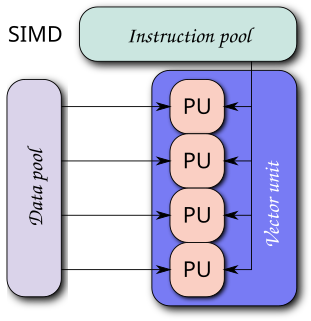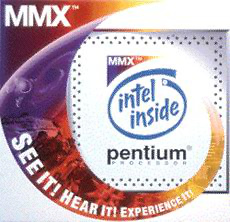mediaLib (from "multimedia library") is a portable low level library for accelerating multimedia applications, with interfaces in C. It was developed by Sun Microsystems and open-sourced under the CDDL license as part of the OpenSolaris project.
It is implemented in ANSI C, but can take advantage of SIMD multimedia instructions on various processors to gain a significant performance boost. It was originally designed to leverage VIS on SPARC processors and later added support for MMX/SSE/SSE2 on Intel/AMD processors.
Since mediaLib is written in C and SIMD multimedia compiler intrinsics, it should be usable on any system that has an ANSI C compiler that supports SIMD multimedia intrinsics. Systems without SIMD intrinsics support can also use it as pure ANSI C, forgoing any extra acceleration provided by SIMD multimedia instructions. It is also included as part of Solaris 10.
mediaLib 2.5 contains about 4000 files and 2.4 million lines of code, and contains more than 3000 functions for different areas:
Open source applications that use mediaLib include Java, JDS for Solaris, mplayer, and ogle.
There are several mediaLib versions targeting different platforms, but all share the same API, so users can switch from one platform to another without changing source code:
- Standard C: written in pure ANSI C, with some general code optimization for performance
- VIS/VIS2/VIS3: optimized for SPARC chips with VIS/VIS2/VIS3 multimedia instruction sets
- MMX/SSE/SSE2: optimized for Intel/AMD chips with MMX/SSE/SSE2 multimedia instruction sets
- Integer: optimized for chips that have no or limited floating point capabilities, such as UltraSPARC T1 and some embedded chips
- Multi-threaded version: A thin wrapper layer built with OpenMP on top of mediaLib, providing flexible multithreading multimedia acceleration for applications

x86 is a family of instruction set architectures initially developed by Intel based on the Intel 8086 microprocessor and its 8088 variant. The 8086 was introduced in 1978 as a fully 16-bit extension of Intel's 8-bit 8080 microprocessor, with memory segmentation as a solution for addressing more memory than can be covered by a plain 16-bit address. The term "x86" came into being because the names of several successors to Intel's 8086 processor end in "86", including the 80186, 80286, 80386 and 80486 processors.

Single instruction, multiple data (SIMD) is a class of parallel computers in Flynn's taxonomy. It describes computers with multiple processing elements that perform the same operation on multiple data points simultaneously. Such machines exploit data level parallelism, but not concurrency: there are simultaneous (parallel) computations, but only a single process (instruction) at a given moment. SIMD is particularly applicable to common tasks such as adjusting the contrast in a digital image or adjusting the volume of digital audio. Most modern CPU designs include SIMD instructions to improve the performance of multimedia use. SIMD is not to be confused with SIMT, which utilizes threads.

MMX is a single instruction, multiple data (SIMD) instruction set designed by Intel, introduced in January 1997 with its P5-based Pentium line of microprocessors, designated as "Pentium with MMX Technology". It developed out of a similar unit introduced on the Intel i860, and earlier the Intel i750 video pixel processor. MMX is a processor supplementary capability that is supported on recent IA-32 processors by Intel and other vendors.
In computing, Streaming SIMD Extensions (SSE) is a single instruction, multiple data (SIMD) instruction set extension to the x86 architecture, designed by Intel and introduced in 1999 in their Pentium III series of Central processing units (CPUs) shortly after the appearance of Advanced Micro Devices (AMD's) 3DNow!. SSE contains 70 new instructions, most of which work on single precision floating point data. SIMD instructions can greatly increase performance when exactly the same operations are to be performed on multiple data objects. Typical applications are digital signal processing and graphics processing.
Visual Instruction Set, or VIS, is a SIMD instruction set extension for SPARC V9 microprocessors developed by Sun Microsystems. There are five versions of VIS: VIS 1, VIS 2, VIS 2+, VIS 3 and VIS 4.
3DNow! is an extension to the x86 instruction set developed by Advanced Micro Devices (AMD). It adds single instruction multiple data (SIMD) instructions to the base x86 instruction set, enabling it to perform vector processing, which improves the performance of many graphic-intensive applications. The first microprocessor to implement 3DNow was the AMD K6-2, which was introduced in 1998. When the application was appropriate this raised the speed by about 2–4 times.
SSE2 is one of the Intel SIMD processor supplementary instruction sets first introduced by Intel with the initial version of the Pentium 4 in 2000. It extends the earlier SSE instruction set, and is intended to fully replace MMX. Intel extended SSE2 to create SSE3 in 2004. SSE2 added 144 new instructions to SSE, which has 70 instructions. Competing chip-maker AMD added support for SSE2 with the introduction of their Opteron and Athlon 64 ranges of AMD64 64-bit CPUs in 2003.
The x86 instruction set refers to the set of instructions that x86-compatible microprocessors support. The instructions are usually part of an executable program, often stored as a computer file and executed on the processor.
In computer software, in compiler theory, an intrinsic function is a function (subroutine) available for use in a given programming language whose implementation is handled specially by the compiler. Typically, it may substitute a sequence of automatically generated instructions for the original function call, similar to an inline function. Unlike an inline function, the compiler has an intimate knowledge of an intrinsic function and can thus better integrate and optimize it for a given situation.
SIMD within a register (SWAR) is a technique for performing parallel operations on data contained in a processor register. SIMD stands for single instruction, multiple data.
Supplemental Streaming SIMD Extensions 3 is a SIMD instruction set created by Intel and is the fourth iteration of the SSE technology.
Intel C++ Compiler, also known as icc or icl, is a group of C and C++ compilers from Intel available for Windows, Mac, Linux, FreeBSD and Intel-based Android devices.
Framewave is computer software, a high-performance optimized programming library, consisting of low level application programming interfaces (APIs) for image processing, signal processing, JPEG, and video functions. These APIs are programmed with task level parallelization (multi-threading) and instruction-level parallelism single instruction, multiple data (SIMD) for maximum performance on multi-core processors from Advanced Micro Devices (AMD).
Intel Integrated Performance Primitives is a multi-threaded software library of functions for multimedia and data processing applications, produced by Intel.
Intel Fortran Compiler, also known as IFORT, is a group of Fortran compilers from Intel for Windows, OS X, and Linux.
The SSE5 was a SIMD instruction set extension proposed by AMD on August 30, 2007 as a supplement to the 128-bit SSE core instructions in the AMD64 architecture.
Advanced Vector Extensions are extensions to the x86 instruction set architecture for microprocessors from Intel and AMD proposed by Intel in March 2008 and first supported by Intel with the Sandy Bridge processor shipping in Q1 2011 and later on by AMD with the Bulldozer processor shipping in Q3 2011. AVX provides new features, new instructions and a new coding scheme.
Extended MMX refers to one of two possible extensions to the MMX instruction set for x86.
An Advanced Encryption Standard instruction set is now integrated into many processors. The purpose of the instruction set is to improve the speed of applications performing encryption and decryption using Advanced Encryption Standard (AES). They are often implemented as instructions implementing a single round of AES along with a special version for the last round which has a slightly different method.
Open Watcom Assembler or WASM is an x86 assembler produced by Watcom, based on the Watcom Assembler found in Watcom C/C++ compiler and Watcom FORTRAN 77. Further development is being done on the 32- and 64-bit JWASM project,. which more closely matches the syntax of Microsoft's assembler.


